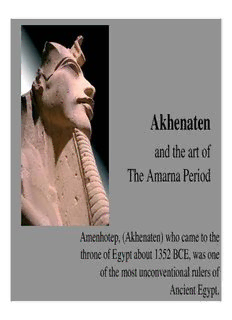
Egypt 3 Amarna period PDF
Preview Egypt 3 Amarna period
Akhenaten and the art of The Amarna Period Amenhotep, (Akhenaten) who came to the throne of Egypt about 1352 BCE, was one of the most unconventional rulers of Ancient Egypt. Amenhotep IV • Initiated radical religious change. • Founded a new religion demanding belief in a single god: The life-giving sun disk Aten. • Changed his name to Akhenaten. “Blessed spirit of the Aten” • Initiated a significant change in artistic styles and subjects. • Moved capital of Egypt from Thebes to Amarna Old versus New Religious Ideas • Akhenaten's worship of Aten as the sole god of creation was revolutionary. • The stela of Wesi shows the worship of the god of the afterlife, Osiris, one of the many gods to whom Egyptians had prayed for centuries. • • The relief from the Great Palace at Amarna depicts Akhenaten's worship of Aten, the light within the sun's disk. See how some elements remained the same, some changed dramatically. Painted papyrus reproduction of the relief from the great palace at Amarna. Representation of the god The Worshipers Offerings and Instruments Offering table Family Members Purpose of the relief • This carving represents an actual ceremony, a daily ritual carried out by the • This funerary monument was probably placed royal family. The carving ornamented a either in Wesi’s tomb or in a temple. Most likely, processional ramp in the Great Palace at he would have commissioned only one such image, specifically to provide for their afterlife. Amarna; many such images were carved for Amarna's buildings.
Description: